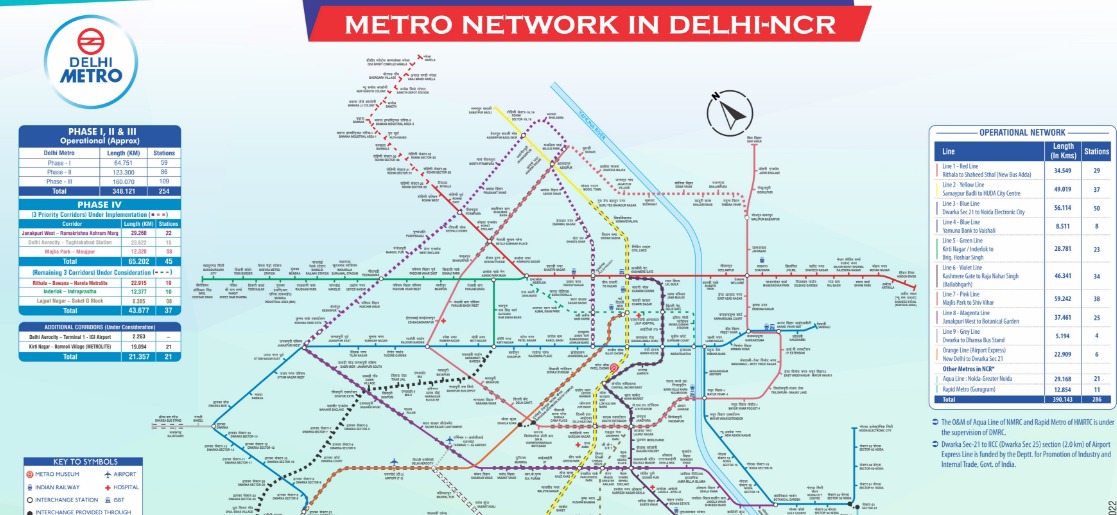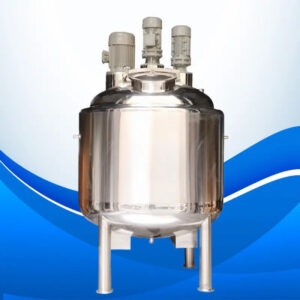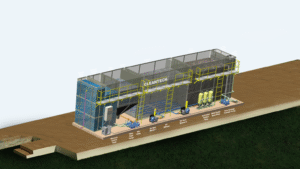Delhi Metro Blue Line 2025: Stations, Route, Maps, and Timings
Navigating Delhi’s vast expanse becomes effortless with the Delhi Metro Blue Line. This line seamlessly connects key areas, offering a...

Navigating Delhi’s vast expanse becomes effortless with the Delhi Metro Blue Line. This line seamlessly connects key areas, offering a reliable mode of transportation for daily commuters and tourists alike.
Comprehensive Overview of the Delhi Metro Blue Line
The Blue Line stretches across 56.6 kilometers, linking Dwarka Sector 21 to Noida Electronic City, with a branch extending from Yamuna Bank to Vaishali. This extensive network encompasses 50 active stations, facilitating smooth transit across Delhi and neighboring regions.
Detailed Route and Station Insights
Embarking from Dwarka Sector 21, the line traverses pivotal stations including Rajouri Garden, Karol Bagh, Rajiv Chowk, and Akshardham, culminating at Noida Electronic City. The branch line initiates at Yamuna Bank and proceeds to Vaishali, enhancing connectivity to Ghaziabad.
Key Interchange Stations Enhancing Connectivity
The Blue Line integrates seamlessly with other metro lines at several interchange stations:
- Rajiv Chowk: Connects with the Yellow Line.
- Mandi House: Links to the Violet Line.
- Dwarka Sector 21: Interfaces with the Airport Express Line.
- Noida Sector 52: Connects to the Aqua Line of Noida Metro.
User-Friendly Route Maps for Effortless Navigation
For a visual representation of the Blue Line’s extensive network, commuters can access detailed maps through the official Delhi Metro Rail Corporation (DMRC) website or the DMRC mobile application. These resources provide real-time updates and comprehensive route information, ensuring a hassle-free travel experience.
Operating Hours and Train Schedules
Understanding the Blue Line’s schedule is crucial for efficient travel planning:
- Weekdays: Services commence at 6:00 AM and conclude at 11:00 PM.
- Sundays and Public Holidays: Operations begin slightly later, starting at 8:00 AM.
Train Frequency During Peak and Non-Peak Hours
- Peak Hours: Trains arrive at intervals of 2–5 minutes, accommodating the high commuter demand.
- Non-Peak Hours: Services are available every 7–10 minutes, maintaining consistent connectivity throughout the day.
State-of-the-Art Facilities for a Comfortable Journey
The Blue Line is equipped with modern amenities to enhance passenger comfort:
- Air-Conditioned Coaches: Provide relief from Delhi’s varying temperatures.
- Accessibility Features: Elevators, ramps, tactile paths, and designated wheelchair spaces ensure inclusivity for all passengers.
- Contactless Travel: Smart cards and QR-code-based tickets facilitate smooth and efficient entry and exit processes.
- Parking Facilities: Available at numerous stations, offering convenient options for commuters who drive to the metro.
Commitment to Passenger Safety and Security
Ensuring the well-being of commuters is a top priority:
- Surveillance Systems: Comprehensive CCTV coverage across stations and trains enhances security.
- Emergency Helplines: Readily accessible at all stations and within trains, providing immediate assistance when needed.
Future Developments: Expanding the Blue Line’s Reach
The DMRC plans to extend the Blue Line from Noida Electronic City to Sahibabad, introducing five new stations:
- Vaibhav Khand
- DPS Indirapuram
- Shakti Khand
- Vasundhara Sector 5
- Sahibabad
This expansion aims to further enhance connectivity and reduce travel time for commuters in these regions.
Benefits of the Delhi Metro Blue Line for Daily Commuters
The Blue Line significantly reduces road congestion by offering a fast and efficient alternative to personal vehicles. With its punctuality and reliability, passengers can plan their journeys without worrying about unexpected delays.
Additionally, the affordability of metro travel makes it a cost-effective option for daily commuters. Instead of spending hours stuck in traffic, individuals can reach their destinations on time while enjoying a comfortable ride.
Green Initiative: Reducing Carbon Footprint
The Delhi Metro system actively contributes to environmental sustainability. The Blue Line operates on energy-efficient technology, significantly reducing carbon emissions. Solar panels installed at multiple metro stations generate clean energy, reducing dependence on non-renewable sources.
Moreover, the shift from fuel-driven vehicles to metro travel helps in controlling air pollution levels in Delhi. By opting for metro services, commuters play a role in creating a cleaner and healthier urban environment.
Upcoming Smart Features for a Seamless Experience
The Delhi Metro continuously improves its services to enhance passenger experience. Future advancements include:
- AI-Based Crowd Management: Predictive algorithms will help in optimizing train schedules and reducing overcrowding during peak hours.
- Digital Payment Upgrades: Expansion of mobile payment options and NFC-enabled transactions for faster ticketing processes.
- Wi-Fi Connectivity: Planned introduction of high-speed internet across all stations and coaches to enhance productivity during travel.
Exploring Tourist Attractions Along the Blue Line
For tourists, the Blue Line provides easy access to some of Delhi’s most iconic landmarks:
- Connaught Place: A shopping and dining hub near Rajiv Chowk station.
- Akshardham Temple: Located close to Akshardham metro station, this architectural marvel attracts thousands of visitors.
- India Gate: Easily accessible via interchange stations, a must-visit historical landmark.
- Dilli Haat: A cultural hotspot offering traditional handicrafts and cuisine, reachable via INA metro station interchange.
Exploring Delhi becomes effortless with the Blue Line’s connectivity, making it the preferred choice for tourists and locals alike.
Pro Tips for a Seamless Commuting Experience
- Stay Updated: Regularly check the DMRC website or mobile app for any schedule changes or maintenance alerts.
- Off-Peak Travel: Plan journeys during non-peak hours to enjoy a more relaxed commute.
- Smart Card Usage: Opt for a rechargeable smart card to benefit from discounted fares and avoid long queues.
Conclusion
The Delhi Metro Blue Line remains an indispensable part of Delhi’s transportation infrastructure. Its extensive connectivity, modern facilities, and commitment to sustainability make it the most convenient choice for commuters and tourists. With planned extensions and upcoming smart features, the Blue Line continues to evolve, offering a seamless and comfortable travel experience for all.
For personalized assistance or further inquiries, feel free to contact us.
Frequently Asked Questions
- What is the total length of the Delhi Metro Blue Line?
- The Blue Line spans 56.6 kilometers, connecting Dwarka Sector 21 to Noida Electronic City and extending to Vaishali.
- How many stations does the Blue Line have?
- The Blue Line consists of 50 stations, including key interchange points.
- What are the operating hours of the Blue Line?
- Trains operate from 6:00 AM to 11:00 PM on weekdays and from 8:00 AM on Sundays and public holidays.
- How frequently do trains arrive?
- During peak hours, trains run every 2–5 minutes, while during non-peak hours, they arrive every 7–10 minutes.
- Does the Blue Line have air-conditioned coaches?
- Yes, all trains on the Blue Line are air-conditioned for passenger comfort.
- Are there parking facilities at Blue Line metro stations?
- Many stations along the Blue Line offer parking facilities for commuters.
- Can I use a smart card for travel?
- Yes, smart cards and QR-code-based tickets are available for seamless travel.
- Is the Blue Line accessible for differently-abled passengers?
- Yes, stations are equipped with elevators, ramps, and tactile paths to ensure accessibility.
- What are the major interchange stations on the Blue Line?
- Key interchanges include Rajiv Chowk, Mandi House, Dwarka Sector 21, and Noida Sector 52.
- What future expansions are planned for the Blue Line?
- The Blue Line is set to extend from Noida Electronic City to Sahibabad, adding five new stations.







